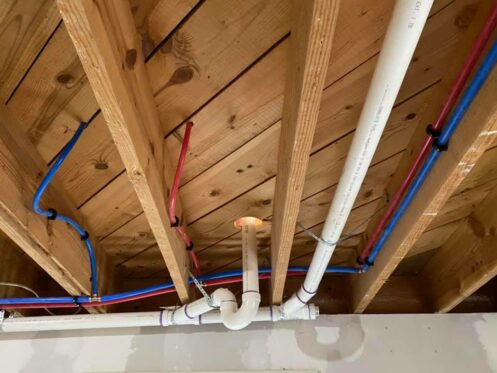Updated January 18, 2024
You have a recent plumbing issue, such as a burst or corroded pipe, and you need to have it fixed with new piping. Or you live in an older home with plumbing that’s so outdated it’s created regular problems with leaks and high-water pressure. In either situation, you need to have professional plumbers handle re-piping services in Des Moines, IA.
Re-piping can be a small task, such as fixing leaks. Or it can be a whole-house re-piping designed to upgrade a vintage home into the twenty-first century of residential plumbing. You can rely on our plumbers to handle the job, no matter its size, with speed and accuracy. We use only the best up-to-date pipe materials for each plumbing job.
But what are the right materials? We’re going to run down the most common piping materials in use today, as well as look at what material they’re replacing.
The outdated materials
Homes constructed before 1970, and especially before World War II (this includes many homes in the Des Moines area), contain plumbing made from materials that are no longer used. Galvanized steel is the most common, but there’s also cast iron and clay, both of which were often used for sewer lines and water mains. These materials decay over time and are susceptible to chemicals in the water. Galvanized steel is prone to corrosion and will usually not last more than fifty years.
Copper
The metal that ousted steel and iron is copper. Copper is well-fitted for plumbing because it is corrosion-resistant, lightweight, inexpensive, and ductile. It’s less likely to break because of pressure, and it will last longer than other types of metal. It can still corrode, however, because of the high acid content in the water, although it still resists most forms of corrosion. The majority of home plumbing systems are now made from copper.
CPVC
This is a type of rigid plastic that is related the PVC but is even more heat resistant. CPVC (which stands for chlorinated polyvinyl chloride) can tolerate heat up to 200°F, making it perfect for hot water lines. It’s easily molded so it can fit into a variety of locations.
PEX
Crosslinked polyethylene, or PEX, is flexible piping with many advantages. It first came into use in the U.S. in 1980 and has spread significantly since then because of the variety of ways it can be used in plumbing systems. It’s resistant to scale build-up and won’t corrode or suffer from pinhole leaks that can affect copper. It requires fewer fittings and can make 90° turns so there’s no need to put in elbows for it. It doesn’t need soldering, so it doesn’t leak lead into the water. Like CPVC, it’s less expensive than copper, and it comes in large spools that make it easy and fast for plumbers to cut the section lengths they need.
No matter what you need when it comes to your home’s plumbing system, you can depend on our plumbers to make the best choice of piping materials.
If you want a Service Provider who will treat you and your home like their own, then call Golden Rule today.
Contact Us Today for Plumbing Service!
If you found this post helpful, check out some other budget-saving tips:





